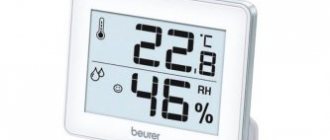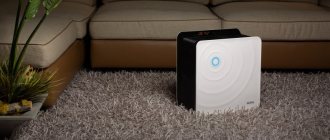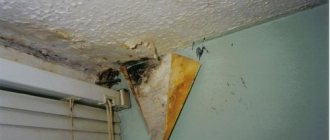Air parameters in the premises of a house are an important component of the well-being of the people living in it. But many people pay attention to temperature, although there is one more indicator that should not be forgotten. This is normal air humidity. Let's figure out what humidity should be in the house, what it affects, how to measure and change.
Optimal humidity value in the house Source navseruki.guru
High or low humidity - what are the problems?
If we talk about humidity as a physical quantity, then this is the amount of water vapor present in a unit volume of a room. Usually 1 m³. It is clear that the volume of a room is the volume of air. That's why they talk about air humidity.
Scientists have divided this parameter into two types:
- Absolute humidity . This is the amount of water in a cubic meter of air mass.
- Humidity is relative . This is the ratio of the absolute value to the maximum possible moisture concentration inside the air at a given temperature. And this ratio of the two indicators is multiplied by 100.
So, when they talk about indoor air humidity - the norm, they mean a relative variety. It is the norm that determines the quality of living of people, the normal growth of house plants, as well as the long-term operation of household appliances, furniture and other household utensils. A large deviation from the norm in one direction or the other reduces the above-mentioned living conditions.
Absolute and relative humidity in the room Source tildacdn.com
For example, how dry air can affect a person:
- human moisture loss through the skin increases;
- accordingly, the elasticity of the skin, hair and nails decreases, and accordingly wrinkles appear, nails split, hair splits;
- the mucous membrane of the eyes dries out, causing symptoms such as “sand” in the eyes, itching, redness;
- the loss of water in the human body, or rather in the blood, leads to its thickening, hence headaches, heart rate increases, blood pressure increases, performance decreases, and weakness appears;
- digestion also slows down because the concentration of fluid inside the gastrointestinal tract decreases, which often leads to constipation;
- immunity decreases due to drying of the mucous membranes of the respiratory tract, which often leads to ARVI;
- The concentration of respiratory allergens in the air increases because they are bound by droplets of moisture if the indoor air humidity is normal.
Dry air is the cause of allergens Source chitazdrav.ru
As you can see, there are many problems with dry air in rooms. But this does not mean that increased humidity will create favorable living conditions. This also has its own problems, which are mainly associated with the appearance of microorganisms such as mold and fungi in the premises. Why are they dangerous:
- residents of such houses suffer from chronic respiratory diseases: allergies, runny nose, bronchitis, asthma;
- there is always a feeling of discomfort, especially humidity and stuffiness;
- the proliferation of microorganisms causes an unpleasant odor;
- Furniture deteriorates, washed clothes take a long time to dry, etc.
How to reduce indoor humidity
If the humidity level in the apartment is higher than normal, you can purchase a special device - a dehumidifier. It forces humid air through an “evaporator”, where the temperature difference (the temperature in the device is lower than in the room) turns the moisture into condensation. Drops of condensate flow into a special container.
The air is heated again and enters the room. Thus, excess moisture disappears from the room. When purchasing a dehumidifier, the main consideration is its performance, which is measured in “liters per day.”
A household dehumidifier can absorb between 12 and 300 liters of water in 24 hours. Dehumidifiers can be portable or stationary. Portable ones can be used in different rooms. Stationary ones are mounted in the wall and cannot be moved. At the same time, they have greater productivity.
The advantage of dehumidifiers is their ability to function in cold rooms, since frost formed during operation is removed automatically. If the water tank is filled and not emptied in a timely manner, the device turns off without the intervention of the owner.
In a small room, you can reduce humidity using moisture absorbers. The device includes a special tablet that adsorbs water from the air.
It is designed for an area of up to 20 m² on average. The disadvantage of the absorber is that the tablet needs to be changed frequently. The advantage is the absence of noise, compactness and price. The moisture absorber is especially suitable for those who experience humidity as a seasonal phenomenon.
Folk remedies for reducing humidity
Among the folk remedies, the simplest one is regular ventilation. The more often it is carried out, the drier the air will become. Even if the humidity outside is higher than at home, when airing the apartment it decreases. The bathroom and toilet are unventilated areas.
They are equipped with hoods for air circulation. However, they do not always cope with the amount of work. Therefore, it would be a good idea to install an exhaust fan.
An oil radiator with a built-in fan will dry the humid air in a small room. The required temperature and humidity level will be maintained by the installed air conditioner.
The sun's rays through uncurtained windows in rooms can dry the air well. The kitchen can also be equipped with extraction systems. They not only help in the fight against humidity, but also remove excess odors.
Feeling comfortable at home is very important for any person. High-quality air in the apartment has a positive effect on the well-being of residents, helping to avoid chronic diseases and allergic reactions to dust or mold. Therefore, it is very important to determine the humidity level in your home and then maintain it at normal levels.
What are the consequences of exceeding the norm for indoor humidity?
An excess of water can also be dangerous for humans, so many people wonder what air humidity is considered normal in an apartment and how to maintain climatic conditions within this indicator. An increased content of water vapor in a room becomes an excellent breeding ground for fungi, mold and harmful bacteria.
- In such conditions, many problems arise:
- The frequency and severity of respiratory diseases is increasing - diseases such as bronchitis, runny nose, allergies and asthma become chronic and difficult to treat.
- The microclimate in the rooms becomes unacceptable for life - people feel damp or stuffy in the rooms.
- The feeling of freshness is lost - the secretions of multiplying pathogenic organisms cause the appearance of unpleasant odors.
- The drying time for washed clothes increases.
Increased air humidity in the apartment is also harmful to the environment. Plants begin to rot, mold appears on the ceiling and walls, and wooden surfaces undergo deformation changes. Books and other paper products change their structure.
What affects humidity
In general, with humidity, or rather with the factors influencing it, the situation is paradoxical. Firstly, it completely depends on the air temperature. Purely according to physical laws, the higher the temperature, the more water can fit into the air. Because it increases in volume under the influence of rising temperatures.
What affects humidity Source 900igr.net
And everything would be so if the conversation was about an absolute indicator. And since we are talking about humidity inside the house, here, as mentioned above, the relative parameter is taken into account. And in this case, physical laws operate in reverse. That is, the higher the air temperature, the lower its humidity will be. This means relative. Because the volume of air has increased, but the amount of water in it has not changed.
What household appliances and objects affect relative humidity:
- heating devices: heating radiators, fireplaces, stoves and others;
- air conditioners;
- carpets, upholstered furniture, soft toys, curtains and more.
But the following devices lead to increased humidity inside the house:
- aquarium;
- leaking pipes;
- boiling kettles and pots;
- the roof, if it leaks somewhere;
- wet laundry hanging inside the house.
An aquarium in a house increases humidity Source yandex.net
See also: Catalog of companies that specialize in complex installation of internal engineering systems of a country house.
Standards
Let's now figure out what humidity should be in the room. Everything will, of course, depend on the purpose of the room and the time of year. But there are regulations where normal humidity is indicated by certain values.
Eg:
- In the warm season, this figure varies in the range of 30-60%. There is such a thing as the maximum permissible norm. It is equal to 65%. In some regions, for example, maritime regions, 75% is considered the norm.
- In cold weather, the norm is 30-45%, the maximum is 60%.
Note! These indicators are only for residential premises and specifically for humans. In rooms such as corridors, hallways, toilets and bathrooms, and storage rooms, humidity is not standardized.
Also, do not forget that there are plants, furniture, household appliances, etc. in the house. For them, the standards are slightly different from the above:
- For plants – 40-70%, for tropical – 80-95%, for subtropical – 75-80%.
- Books are best stored at a humidity of 30-65%.
- Furniture and paintings are well preserved at 40-60%.
- The same goes for antiques.
- For technology, 45-60% is suitable.
Optimal humidity in the house Source ventilation-conditioning.ru
So, the optimal humidity in a room for a person is from 30 to 60%. But if children live in the house, then the standard in their rooms is slightly different. Here this figure should be in the range of 50-70%. Because children are more sensitive to various harmful bacteria, infections and other parasites. Plus, they have a higher intensity of heat exchange processes in the body. That is, they release moisture faster, due to which the fluid content in the body decreases. Therefore, doctors recommend that sick children stay in rooms where the humidity does not drop below 60%.
Attention! In the winter season, when the heating system is turned on in houses, the moisture content inside the rooms decreases sharply - by 15-20%. Therefore, if your family has children, as well as asthmatics and allergy sufferers, then this air parameter must be maintained artificially.
Heating appliances greatly reduce indoor humidity Source naimtruda.com
Rules for measuring relative humidity
Having decided on the norm of humidity in the room, we will understand the methods for measuring it. The easiest and most accurate way is to use a hygrometer. In stores, this device is presented in a wide variety. And they differ from each other in the measurement method and operating principle. Namely:
- electrical;
- condensation;
- hair;
- chemical and others.
Psychrometric hygrometer, also known as psychrometer Source 900igr.net
How to maintain normal humidity?
If the humidity level in the room is too low, the best solution is to use a special device - a humidifier. There are several types of such devices:
- Traditional - a special reservoir is filled with water, which then goes to the filter or cartridge. The fan drives air through them and returns it to the room cleaned and humidified;
- Steam - the water is heated, the air is saturated with moisture due to hot steam;
- Ultrasonic - the hearth is fed onto a plate that vibrates under the influence of ultrasound. The dispenser sprays water in the form of microscopic particles that are held by air molecules.
Humidifiers have many useful additional functions: they automatically turn off, can work as fragrances, purify the air using filters, and switch to quiet night mode. But their main advantage is the ability to quickly increase air humidity to a normal level and maintain it for a long time.
Video description
In the video, a specialist talks about psychrometers and how they can be used to measure indoor air humidity:
There are other measurement options that can be classified as “folk”. The easiest one here is to use a glass of water. It is pre-cooled to +5 °C, for example, it can be placed in the refrigerator for several hours. And then they are placed in a room away from heating devices.
If the outer surfaces of the glass dry quickly, say in a few minutes, then the humidity in the room is greatly reduced. If there is evaporation left on them and it does not disappear, the humidity in the room is normal. If streams of water flow down the walls of the glass, then most likely the humidity in the room is high.
Foggy glass of cold water Source onegoodthingbyjillee.com
How can you regulate humidity?
You need to choose methods of change depending on whether this parameter is high or low. Let's start with the first one, that is, high humidity. What can you offer:
- organize frequent ventilation;
- install dehumidifiers;
- install hoods;
- constantly monitor plumbing and heating, water supply and sewerage pipes so that they are in sealed and in good condition;
- use different types of heaters to heat the house;
- Do not dry laundry inside.
Now about how you can increase relative humidity:
- install an aquarium or a decorative fountain in one of the rooms;
- use air conditioners and heaters as little as possible;
- install sprinklers, also known as humidifiers, or do it with a hand sprayer;
- carry out wet cleaning more often;
- place wet towels on heating radiators;
- plant as many house plants as possible.
Preventing dampness in the home
For prevention, it is worth remembering the following tips:
- After washing, showering, taking a bath, ventilate the bathroom.
- You should not dry clothes in the apartment. There is a balcony for this. Modern washing machines also have a drying function.
- Install plastic windows with ventilation.
- Avoid using an aquarium, fountain or indoor waterfall.
- Among indoor plants, choose succulents and cacti. They do not need frequent watering.
So, high humidity in apartments is a very common problem. Follow simple prevention tips and you will not encounter this extremely unpleasant phenomenon.
Enemies of air humidity
So, having dealt with the question of what humidity should be in a living room, we move on to household appliances, which greatly underestimate this parameter. Let's start with the fact that all electrical appliances heat up and produce heat. And accordingly, they heat the air temperature inside the house, reducing humidity.
Of particular note is the air conditioning, which everyone uses in the summer. Its operating principle is based on the fact that the device takes in humidity, condensing it on a heat exchanger located in the indoor unit. And this water is carried out into the street through a tray and a hose.
Here you need to add TVs, computers and other electrical appliances. But the most serious enemy of the humidity regime is the heating system of the house. In winter it can reduce this parameter to 20%, which is already considered a critical value.
Many people try to solve this problem by ventilation. But not many people know that there is little moisture in cold air. And if you let it into the room, it heats up, expands and becomes dry.
Temperature and humidity in the children's room
If there is a newborn child in the family, then parents need to pay close attention to controlling the microclimate in the children's room. The air temperature in maternity hospitals and perinatal centers does not exceed 22 degrees. For a children's room, the optimal temperature range is from 18 to 21 degrees.
Despite the fact that a newborn baby is in a sedentary state, many biochemical processes occur in his body, which are accompanied by the release of thermal energy. If the room temperature is more than 22 degrees, then the baby is at risk of overheating. An equally important indicator is the percentage of moisture in the air. For a children's room, the optimal value is from 50 to 70%. If a newborn baby suffers from infectious and inflammatory diseases, then the air humidity should not fall below 60%.
Excessive air temperature in a children's room leads to the development of the following conditions:
- Drying of the mucous membrane of the nasal passages, resulting in the formation of dry crusts that prevent normal breathing through the nose;
- Excessive dryness of the oral mucosa, which entails the formation of a disease such as thrush;
- Formation of irritation and diaper rash of the skin in the area that is under the diaper and in the groin folds;
- An increase in the viscosity of gastric juice, which is caused by a lack of fluid in the body.
Increased sweating poses a danger to the child's body, since this condition is accompanied by massive loss of fluid through the skin pores.
The condition in which a child’s body is exposed to hypothermia is no less dangerous for the body of a newborn baby. You can recognize the symptoms of hypothermia in a child’s body by the following signs:
- Paleness of the skin;
- Coldness of the child's upper and lower extremities;
- Blue discoloration of the skin in the area of the nasolabial triangle.
Important! If there is a premature baby in the family, then it is necessary to create individual microclimatic conditions for him. Increased attention to such children is due to the immaturity of thermoregulation mechanisms, as a result of which a newborn baby is not able to perceive fluctuations in temperature and humidity of the environment.
If high temperatures prevail in residential premises, then to prevent overheating of the child’s body, you can use the following tips:
- It is recommended to ventilate the children's room at least 3 times a day. During this procedure, it is recommended to take the baby to another room;
- If an air conditioner is installed in a living room, then its air flows should not be directed to the place where the newborn baby is located;
- If the air temperature in the children's room exceeds the permissible norms, then it is recommended to undress the child, leaving only one diaper on him;
- If central heating radiators supply too much heat, then parents are advised to cover them with blankets, rugs and other fabrics that can retain heat flow.
- To prevent overheating, it is recommended to resort to water procedures as often as possible. The frequency of bathing a newborn baby can reach 3-4 times a day;
- If a canopy is installed above the baby's crib, then it must be eliminated, since this product not only disrupts heat transfer, but is also a source of accumulation of household dust.
If there is a decrease in temperature in the children's room, then parents need to take care of purchasing sources of heat generation. It is recommended to place a standard household heater at a distance from the place where the newborn baby is located. It is strictly forbidden to cover any types of household heaters with fabric products.
Interesting Facts
It is a well-known fact that fog means one hundred percent humidity. But this natural phenomenon is possible only at a temperature of 0 °C. If the fog is placed in a room with a temperature of +22 °C, then the humidity in such a room will become only 23%. This shows well how temperature changes humidity.
Dry air seems colder to us. And vice versa. It's all about our body, which produces sweat in hot weather. The latter is moisture, which performs the functions of thermoregulation of the body. That is, sweat makes our skin moist, thereby removing heat from its surface. The same thing happens in winter. Only in this case does dry air cool the skin. Therefore, this air seems colder to us.
Please note that an increase in temperature of just 2 °C entails a decrease in humidity by 25%. Therefore, you should not heat your home too much. Room temperature, namely +18-22 °C, is the optimal mode in which the humidity is also in ideal condition. That is, by adhering to these two parameters, you can save a lot of money on heating your home in winter.
How does a person feel at different air humidity Source v.5klass.net
What to do if the air in the apartment is too dry?
Diagnostics:
hygrometer readings: up to 25-30%. External signs: leaves of houseplants dry out, laundry dries quickly after washing, dry mouth and thirst are felt.
Consequences:
nasal congestion, dry cough, ineffectiveness of skin moisturizer, exacerbation of allergies to dust (circulating throughout the room at low humidity levels), drying out of the mucous membranes and, as a result, increased vulnerability of the body to pathogens, deterioration of vision. Furniture, building materials, and even musical instruments made of wood can suffer from too dry air.
Briefly about the main thing
The optimal air humidity in residential premises is 30-60%. In children's rooms it is better to keep it at 70%. This also applies to rooms where asthmatics and allergy sufferers live.
The simplest device that measures indoor humidity is a psychrometric hygrometer, also known as a psychrometer.
It is useless to ventilate rooms in winter to increase humidity. Because there is little moisture in cold air. Once inside the house, it heats up, becoming dry, which helps reduce the humidity level.
The biggest enemy of humidity is the heating system of the house. But this indicator is also affected by all electrical household appliances.
To increase this indicator, it is recommended to install household humidifiers; fortunately, they are presented in a huge assortment in stores.










